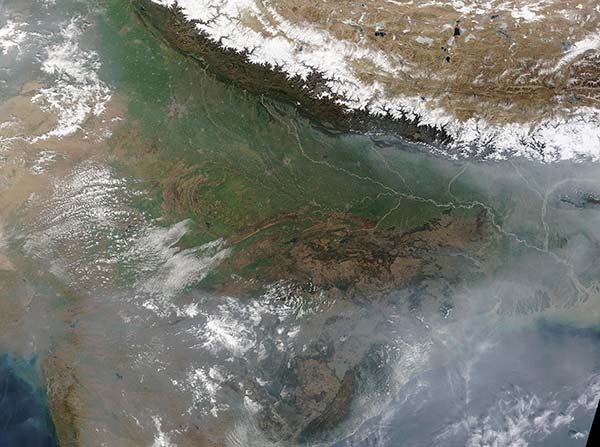Images
February 21, 2022 - Aerosols over India and Bangladesh
Tweet
A broad blanket of haze hung over India and Bangladesh in mid-February 2021. The Moderate Resolution Imaging Spectroradiometer (MODIS) on board NASA’s Terra satellite acquired a true-color image of the scene on February 18. The thickest haze sits at the base of the Himalayas and over Bangladesh, where it nearly obscures the ground from view. In contrast, the air over the high elevations of the Himalayas and the Tibetan Plateau remains crystal-clear.
Winter haze is a regular visitor in northern India, and typically is caused by a complex mix of aerosols (tiny particles suspended in air) and weather conditions. Winter aerosols in this region include pollution from the densely-populated Indo-Gangetic plain, industry, smoke, and dust blowing from the Thar Desert, which sits between India and Pakistan. Cold seasonal temperatures contribute to the buildup of haze as they trap the cooler air near the Earth under a high layer of warmer air. The layer of high warm air acts like a lid, stopping the upward flow of low-level air and thus the dispersion of aerosols and haze.
Image Facts
Satellite:
Terra
Date Acquired: 2/18/2022
Resolutions:
1km (482.6 KB), 500m (2.1 MB),
Bands Used: 1,4,3
Image Credit:
MODIS Land Rapid Response Team, NASA GSFC
Tweet
A broad blanket of haze hung over India and Bangladesh in mid-February 2021. The Moderate Resolution Imaging Spectroradiometer (MODIS) on board NASA’s Terra satellite acquired a true-color image of the scene on February 18. The thickest haze sits at the base of the Himalayas and over Bangladesh, where it nearly obscures the ground from view. In contrast, the air over the high elevations of the Himalayas and the Tibetan Plateau remains crystal-clear.
Winter haze is a regular visitor in northern India, and typically is caused by a complex mix of aerosols (tiny particles suspended in air) and weather conditions. Winter aerosols in this region include pollution from the densely-populated Indo-Gangetic plain, industry, smoke, and dust blowing from the Thar Desert, which sits between India and Pakistan. Cold seasonal temperatures contribute to the buildup of haze as they trap the cooler air near the Earth under a high layer of warmer air. The layer of high warm air acts like a lid, stopping the upward flow of low-level air and thus the dispersion of aerosols and haze.
Image Facts
Satellite:
Terra
Date Acquired: 2/18/2022
Resolutions:
1km (482.6 KB), 500m (2.1 MB),
Bands Used: 1,4,3
Image Credit:
MODIS Land Rapid Response Team, NASA GSFC




